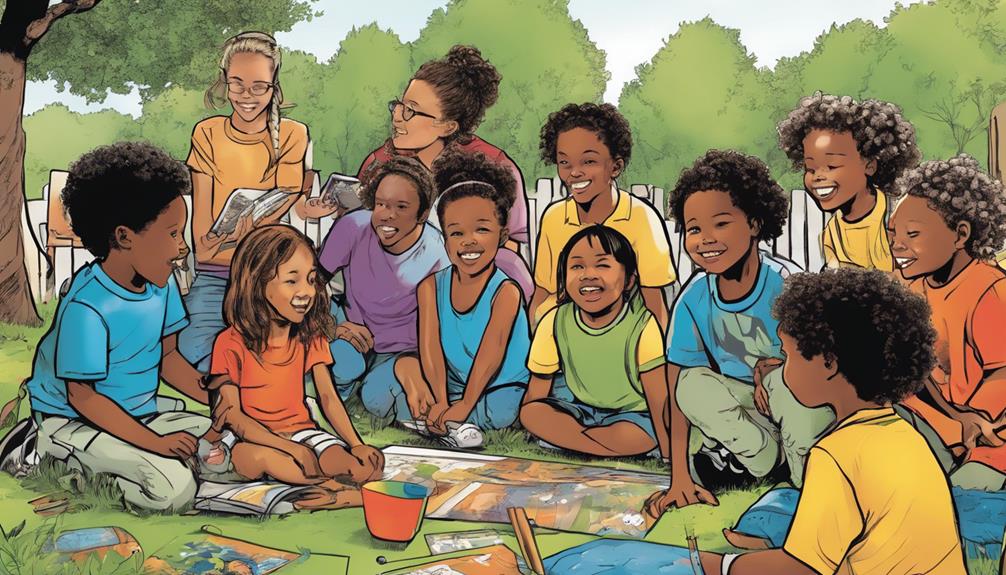Reveal the magic of EYLF practices to enhance child development to extraordinary levels! Embrace holistic approaches that nurture emotional, social, physical, and intellectual growth through engaging activities like stories, songs, and outdoor exploration. Utilize responsive teaching strategies to cater to individual learning styles, providing positive reinforcement and prompt feedback for progress. Emphasize the significance of play, fostering creativity, problem-solving, and social skills essential for lifelong benefits. By observing and tailoring teaching strategies to cater to each child's unique needs, you create positive learning environments that inspire a love for learning and personal growth. Harness the potential of EYLF practices for unparalleled child development outcomes.
Key Takeaways
- Incorporate holistic development approaches to nurture emotional, social, physical, and intellectual growth.
- Use responsive teaching strategies like active listening and adaptability to cater to individual learning styles.
- Emphasize the importance of play in stimulating cognitive, emotional, and social skills.
- Utilize observation for personalized learning, identifying needs, and preferences for tailored teaching.
- Create positive learning environments that are safe, encouraging, and supportive for child development.
Holistic Development Approaches

Holistic development approaches aim to nurture children's emotional, social, physical, and intellectual growth through a thorough integration of various activities and experiences. By incorporating a wide range of activities like stories, songs, games, outdoor exploration, and creative projects, children can develop holistically, benefiting from cognitive, physical, and emotional enhancements.
These approaches guarantee that children not only learn academically but also develop essential life skills such as problem-solving, creativity, and emotional intelligence. Creating a well-rounded environment that caters to all aspects of a child's development sets a strong foundation for their future success and well-being.
Encouraging children to engage in diverse activities helps them explore their interests, build relationships, and develop a deep understanding of themselves and the world around them.
Responsive Teaching Strategies

In educational settings, responsive teaching strategies play a vital role in fostering children's development and learning experiences. These strategies aim to create an environment where children feel heard, valued, and supported in their educational journey.
Here are four key responsive teaching strategies:
- Active Listening: Engage with children by actively listening to their thoughts and feelings, fostering a sense of connection and understanding.
- Flexibility: Adapt teaching methods to cater to individual learning styles and preferences, ensuring each child receives personalized attention.
- Encouragement: Provide positive reinforcement and encouragement to boost children's confidence and motivation to learn.
- Prompt Feedback: Offer timely feedback to guide children's progress and reinforce positive behaviors.
Importance of Play in Development

Playing is a fundamental aspect of child development, fostering essential skills and promoting overall well-being. Through play, children engage in activities that stimulate their physical, cognitive, emotional, and social development. Play allows children to explore their creativity, problem-solving abilities, and imagination in a fun and interactive manner.
It also helps them build relationships, develop communication skills, and learn to navigate social situations effectively. Additionally, outdoor play provides children with exposure to nature, fostering a sense of curiosity and appreciation for the environment around them. By incorporating play into daily routines, parents and educators can support children in developing a well-rounded skill set that will benefit them throughout their lives.
Observation for Individualized Learning

Effective observation techniques play a pivotal role in tailoring teaching methods to meet the individual learning needs of children. Observing children closely allows educators to understand their strengths, weaknesses, interests, and learning styles. By incorporating observation into teaching practices, educators can create personalized learning experiences that cater to each child's unique requirements.
Here are some key aspects of observation for individualized learning:
- Identifying each child's preferred learning style
- Noting specific areas where a child may need extra support
- Recognizing patterns in a child's behavior or responses
- Tailoring teaching strategies based on observed preferences and needs
Through careful observation, educators can adapt their approaches to make certain every child receives the support and guidance they need to thrive in their learning journey.
Creating Positive Learning Environments

To foster ideal child development, establishing supportive learning environments is essential for facilitating positive learning experiences.
Positive learning environments play a vital role in shaping children's growth and overall well-being. These environments are characterized by safety, encouragement, and opportunities for exploration and creativity.
By creating spaces where children feel valued, respected, and motivated, educators can inspire a love for learning and personal development. Supportive learning environments help children build confidence, develop social skills, and enhance their cognitive abilities. They also contribute to a sense of belonging and security, fostering a positive mindset towards education.
Ultimately, these environments lay the foundation for lifelong learning and success, setting children on a path towards reaching their full potential.
Embracing EYLF Principles

Embracing the Early Years Learning Framework (EYLF) principles is essential in providing a holistic approach to nurturing children's development and learning experiences. By incorporating these principles into daily practices, educators and parents can create an enriching environment that supports children's growth and well-being.
Here are four key ways to embrace EYLF principles:
- Prioritize play-based learning to foster creativity and social skills.
- Tailor teaching strategies to meet individual children's needs.
- Encourage active participation and exploration in learning activities.
- Foster collaborative partnerships with families to support children's holistic development.
Facilitating Meaningful Learning Experiences

In creating meaningful learning experiences for children, it is crucial to prioritize activities that align with their strengths, weaknesses, and interests. By tailoring learning experiences to individual needs, children are more engaged and motivated to explore and discover.
Incorporating a variety of activities such as storytelling, games, outdoor adventures, and creative arts can stimulate different aspects of a child's development. Through interactive and hands-on experiences, children not only learn academic concepts but also enhance their social, emotional, and physical skills.
Observing children's reactions and adjusting teaching strategies accordingly guarantees that the learning process remains dynamic and engaging. Ultimately, facilitating meaningful learning experiences empowers children to grow, learn, and thrive in a supportive and enriching environment.
Frequently Asked Questions
How Can EYLF Practices Be Integrated Into Everyday Routines?
Integrating EYLF practices into daily routines involves incorporating holistic approaches like storytelling and play, being responsive to children's needs, utilizing observation to tailor teaching, creating positive learning environments, and focusing on belonging, being, and becoming for meaningful learning experiences.
Are There Specific Guidelines for Implementing EYLF Principles at Home?
Implementing EYLF principles at home involves creating a nurturing environment that supports holistic child development. By incorporating activities like storytelling, play, and responsive interactions, caregivers can promote cognitive, emotional, social, and physical growth effectively.
What Are Some Creative Ways to Encourage Emotional Development in Children?
Creative ways to encourage emotional development in children include storytelling to explore feelings, incorporating role-playing to understand empathy, engaging in art activities for self-expression, using mindfulness exercises for emotional awareness, and encouraging open communication to express emotions effectively.
How Can Parents and Educators Collaborate to Support EYLF Outcomes?
While it may seem counterintuitive, parents and educators can forge a powerful union to bolster EYLF outcomes. By aligning goals, fostering open communication, and sharing insights, this collaboration can create a robust support system for children's holistic development.
Are There Resources Available to Help Understand and Implement EYLF Effectively?
Yes, there are numerous resources available to aid in understanding and effectively implementing EYLF practices. These resources include guides, training materials, workshops, and online platforms that offer valuable insights and support for parents and educators.
Conclusion
To sum up, adopting Early Years Learning Framework (EYLF) practices is crucial for unleashing the full potential of child development.
Did you know that 90% of a child's brain development occurs before the age of five?
By integrating EYLF principles such as responsive teaching, play-based learning, and observation-based adaptations, we can establish positive learning environments where children can thrive and grow.
Let's harness the power of EYLF practices to nurture the holistic development of young minds and set them on the path to success.










